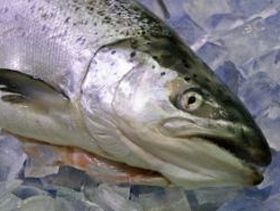 is rich in fat, but fillets of farmed salmon contain less marine omega-3 than previously, because a large fraction of the fish oil in the feed has been replaced by plant oil. Scientists have discovered a way of stimulating farmed salmon to convert plant oil in the feed to marine omega-3.
is rich in fat, but fillets of farmed salmon contain less marine omega-3 than previously, because a large fraction of the fish oil in the feed has been replaced by plant oil. Scientists have discovered a way of stimulating farmed salmon to convert plant oil in the feed to marine omega-3.This means that farmed salmon may become a net producer of marine omega-3.
Natural ability
Salmon have a natural ability to convert omega-3 fatty acids from plants into the marine omega-3 fatty acids EPA and DHA. This ability is greatest in the fish before smoltification. This is the process by which the salmon become physiologically able to move from freshwater to seawater, which occurs in nature when the fish follow river water out into the sea. It is this ability that scientists at the food research institute Nofima have used.
The scientists wanted to find out whether it is possible to retain the ability of farmed salmon to convert omega-3 fatty acids by delaying smoltification and keeping the fish in freshwater longer. It is normal in today’s aquaculture industry that salmon smoltify and are transferred to seawater before they reach a weight of 100 gram.
Two groups of fish
The timing of salmon smoltification is controlled by light, and this fact was used to create one group of salmon destined to smoltify early (at weight 85 gram) and another group destined to smoltify late (at weight 400 gram). After the salmon that weighed 85 gram had been transferred to seawater, all of the fish were given feed in which only 10 per cent of the fat came from fish oil, with the remaining 90 per cent from rapeseed oil.
An investigation carried out by Nofima of the three largest feed suppliers has shown that the corresponding figures for commercial feed last year were approximately 35 per cent from fish oil and 65 per cent from rapeseed oil.
Larger smolts – richer in omega-3
The results from the experiment showed that salmon that had remained in freshwater until they weighed 400 gram had a higher fraction of marine omega-3 fatty acids than salmon that had remained in freshwater until they weighed 85 gram and then transferred to seawater, where they remained until they weighed 400 gram. The fractions of the total fatty acids for marine omega-3 in the two groups were 9.2 per cent and 7.5 per cent, respectively. The experiment has thus shown that it is possible to retain the ability of the salmon to convert omega-3 fatty acids from plants to marine omega-3 fatty acids by delaying smoltification and keeping the fish longer in freshwater. Fish then produce a greater amount of marine omega-3 in total.
“This is an important result, since the levels of healthy marine omega-3 fatty acids in farmed salmon are central to the health of the salmon themselves, and for the health-promoting qualities of the salmon products that we eat,” says scientist Tone-Kari Knutsdatter Østbye at Nofima.
A positive aquaculture industry
The project has been commissioned by the Norwegian Seafood Research Fund (FHF). FHF’s R&D director in aquaculture, Kjell Maroni, believes that the production of larger smolts can be a way forward for more facilities in the aquaculture industry.
“Many companies in the aquaculture industry use a strategy in which parts of the smolt production are kept in freshwater until they are larger than the size at which smoltification has normally taken place in recent years. This makes the growth period before slaughter shorter, and contributes to a lower risk of diseases such as salmon louse. It can only be positive if this strategy contributes also to an increased use and increased natural production of omega-3 in the salmon.”
The scientists wanted to investigate also whether different salmon families differ in their ability to convert omega-3 from plant oils to marine omega-3 fatty acids, and how the salmon families react to the delay in smoltification.
A gene for omega-3 conversion
Salmon were therefore selected on the basis of a single gene – the gene that controls the production of an enzyme known as delta-6-desaturase. This enzyme is known to be a key element in the conversion of plant omega-3 to marine omega-3 fatty acids. Nofima has carried out its own preliminary studies in selecting for this particular gene, and the research institute has used information stored in gene banks, which are freely available databases that store gene sequences.
These experiments were started after a single generation of salmon families from breeding company SalmoBreed had been subject to selection. Salmon with a high or a low expression of delta-6-desaturase were selected as parents, and their offspring were tested in the experiments.
Offspring from salmon selected for a high expression of the gene had a higher capacity for producing omega-3 fatty acids than offspring from salmon with a low expression of the gene.
“Our studies of gene expression and fatty acid composition have confirmed that several factors affect the ability of salmon to convert omega-3 fatty acids. These factors include light cycling, transfer to seawater, the age of the salmon, and their genetic background,” says Østbye.
The project has been carried out as a collaboration between Nofima, SalmoBreed and Biomar, and Gerd Marit Berge from Nofima has been project manager. The experiments were carried out at Nofima’s research station at Sunndalsøra.
“This has been a productive multidisciplinary collaboration in which we have combined expertise in nutrition, breeding, and biotechnology in Nofima, and where we have collaborated closely with breeding companies and feed manufacturers. This has led to exciting results,” concludes Østbye.





